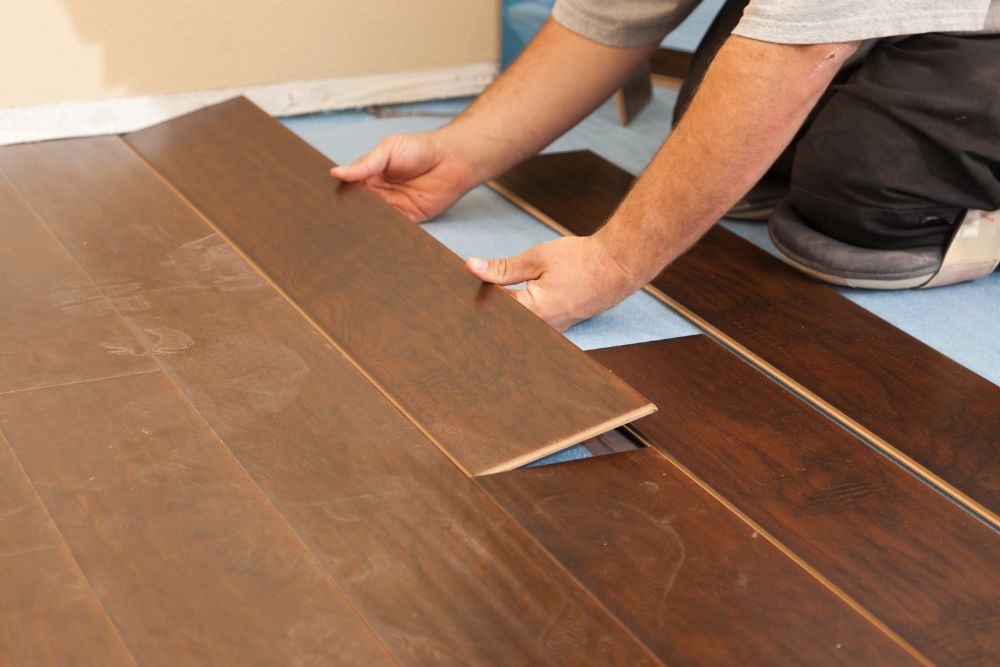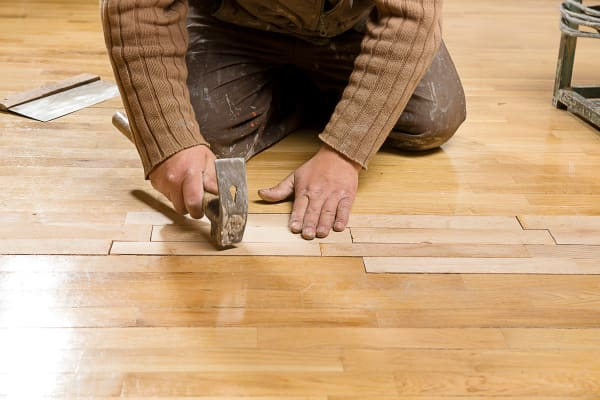Have you ever walked across your laminate floor only to be greeted by an annoying squeak or spotted a visible gap between the planks? These small issues may seem minor at first, but can become frustrating over time. Fortunately, there’s good news-you don’t have to live with these problems.
This guide explains exactly why laminate floors squeak or separate and walks you through the simple, effective steps to fix them and enjoy a floor that looks and feels as good as new. Read on!
Why Laminate Floors Squeak in the First Place
Laminate floors frequently make a squeaking sound because of the movement that occurs between the planks. In situations where the flooring is not firmly attached or where there is room for it to shift, this movement occurs.
These sounds can also be produced by subfloors that are damaged or uneven in distribution. The appearance of warping and an increase in squeaks can be caused by moisture that penetrates the flooring.
The floor may expand or contract as a result of temperature changes, which also adds pressure between the boards. When it comes to squeaks, one of the most common causes is improper installation techniques.
There are times when there is not sufficient space around the perimeter for the floor to take up more space. The underlayment that is underneath the planks could also be the cause of the problem. Finding the origin of the issue is the first step in finding a solution to the problem.
Common Reasons Laminate Floors Separate
Incorrect installation is typically the cause of the separation between laminate boards. The boards will inevitably become disjointed over time if they are not clicked together tightly.
The expansion or contraction of the planks may also be caused by conditions that are dry or high in humidity. The use of an underlayment of poor quality can cause the planks to move around an excessive amount.
Another factor that could cause separation is walking on a floor too soon after it has been installed. The boards can become separated if heavy furniture is dragged across the floor.
When moisture seeps through the underside of planks, it can cause them to swell and split. Foot traffic may, over time, cause the connections between the planks to become more loose. Having an understanding of these factors makes it simpler to put an end to the separation.
Checking for an Uneven Subfloor
One of the most common reasons for laminate floors to produce squeaking sounds and to separate from one another is an uneven subfloor. While you are walking around the room, feel for areas that are lower or higher than others.
Make use of a long level or straightedge in order to locate areas that are uneven. It is necessary to pay attention to the subfloor if the level is wobbling or if there are areas that are visible underneath.
It is also possible to create high points by using raised nails or screws. If the subfloor is made of plywood, it might be necessary to sand it in order to make it more even.
There is a possibility that concrete subfloors require self-leveling compound. Making repairs to the subfloor will provide a solid foundation for your laminate flooring.
The Importance of Acclimating Laminate Before Installation
Before it can be installed, laminate flooring must be given sufficient time to adjust to the temperature and humidity of the room. Acclimation is the term used to describe this process, which typically takes between forty-eight and seventy-two hours.
In the event that this step is skipped, the boards may expand or contract after they have been installed. Squeaking or gaps between the planks are the result of this.
Always ensure that the boxes are opened and that the planks are laid out in a flat position within the room. While this is going on, make sure that the room is kept at normal living conditions. Because of this, the flooring is better able to adjust to its surroundings.
Acclimatization is a simple method that can be used to avoid different problems in the future. This ensures that the floor will last for a longer period of time.
Fixing Minor Gaps Between Planks

There are times when it is possible to fix small gaps between laminate planks without having to remove the floor. A floor gap fixer tool or a rubber mallet and block can be utilized for this task.
The separated boards should be tapped back into place in a gentle manner. Be careful not to hit the planks too hard, as this could cause damage to them.
There is also the option of applying a small amount of wood glue to secure the boards in position. For the duration of the drying process, apply pressure by means of clamps or heavy books.
Before you begin the process of fixing, check that the planks are clean and dry. When installing floating floors, it is important to ensure that expansion gaps are still present at the walls. It is possible to quickly fix annoying gaps with simple tools.
Repairing Larger Separation Issues
There may be a need for additional work if the spaces between the planks are substantial. A significant number of instances require the floor to be partially removed and then reinstalled.
The first step is to lift the planks that surround the affected area. Inspect the subfloor for any signs of damage and clean it.
It is important to carefully reinstall the planks and make sure that they click together tightly. If you want the joints to be more secure, you might want to consider adding glue to them.
After the repair is complete, reinstall any baseboards or trim that were removed. Wait until the floor has had time to settle before you walk on it again.
Although it takes more time, this process is effective in restoring the floor’s appearance. In order to achieve the best results, in-depth work is required for large gaps.
Quieting Squeaky Floorboards from Above
If your floor is making a squeaking sound but you are unable to access the subfloor from below, you should attempt to fix it from above. When you are walking slowly across the floor, you will find the noisy spot.
The seams should be sprinkled with talcum powder or baby powder, depending on your preference. There is less friction between the planks as a result of the powder.
To facilitate the powder’s incorporation into the area, use a rubber mallet to give it a light tap. Utilizing a dry cloth, clean the surface of the object.
In the event that powder does not work, you can try applying glue to the joints and clamping them for two nights. These simple techniques can put an end to those annoying squeaks. Simple adjustments can have a significant impact.
Using Underlayment to Stop Noise
In this case, the underlayment acts as a cushion and supports the laminate planks. A good underlayment stops movement, which stops squeaking.
You might want to get new underlayment if the one you have now is damaged or too thin. Pick out an underlayment that is made to work with laminate flooring, preferably one that can cut down on noise.
When the floor is put back down, the underlayment should be spread out evenly so that there are no wrinkles or gaps. Make sure that each plank can rest on it completely. The floor and subfloor don’t rub against each other as much because of this.
In addition, underlayment helps keep changes in temperature and moisture under control. For a floor to be stable and quiet, it needs the right underlayment.
Moisture Problems and Laminate Damage
Water is not something that laminate flooring enjoys. It is possible for even minute amounts of moisture to instigate warping or separation.
Do a leak check in the area around the windows, sinks, and dishwashers. If necessary, make use of a moisture meter. Never wait to clean up any spills that may occur.
A humidity level that is between 35 and 65 percent is ideal. A dehumidifier is something you should think about using if you live in a damp area. Steer clear of using steam mops or other wet cleaning methods on laminate.
As a prerequisite for repairing the floor, moisture issues need to be resolved. When floors are dry, they last longer and remain in better condition.
Seasonal Changes and Flooring Movement

When the temperature and humidity change, laminate flooring may expand or smaller. Dry air in the winter can make the boards shrink and leave gaps.
In the summer, when it’s humid, they may get bigger and squeak. Use humidifiers or dehumidifiers to keep the temperature and humidity inside stable.
Moving gaps in the walls shouldn’t be blocked by heavy furniture. The floor can move freely because of these gaps. In big rooms, you can use transition strips if you need to.
Setting the right temperature is an important part of floor care. Knowing how the seasons affect things can help you protect your laminate.
Furniture Pads and Floor Protection
Heavy furniture can damage laminate and cause it to separate. Always use furniture pads under chairs, tables, and sofas.
These pads allow different types of furniture to move without dragging. They also reduce pressure on the floor.
Check and replace worn-out pads often. When moving furniture, lift it instead of pushing.
Consider using furniture coasters under larger pieces. Rugs can also help protect high-traffic areas.
Taking care of your floor prevents damage and helps it last longer. Small steps can prevent big problems.
Replacing Damaged Planks
Sometimes, a squeaky or separating plank is simply damaged beyond repair. In this case, it’s best to replace it.
Start by removing the baseboards near the damaged area. Carefully lift out the damaged plank using flooring tools.
Make sure the subfloor is clean and dry before installing a new one. Choose a matching plank and click it into place. Reinstall any baseboards removed.
Walk over the area to check for stability. Replacing bad boards keeps the floor looking and working its best.
Maintaining a Regular Cleaning Routine
Keeping your laminate floor clean is key to preventing wear and tear. Use a dry or slightly damp mop regularly.
Avoid soaking the floor with water or using harsh chemicals. A microfiber mop is gentle and effective.
Sweep or vacuum daily to remove dirt that causes scratches. Clean spills right away to avoid moisture damage. Stick to products made for laminate flooring.
A regular cleaning routine helps maintain the floor’s appearance and strength. Clean floors are quiet floors.
How to Prevent Gaps After Installation
To stop gaps from forming in the future, take time during installation. Make sure each plank is fully clicked into the next.
Use spacers to create proper expansion gaps around the room. Keep the subfloor flat and dry.
Use a high-quality underlayment for stability. Follow the manufacturer’s guidelines closely.
Don’t rush the process. Good planning results in a smooth, gap-free floor. Preventing issues starts with smart installation.
When to Call a Professional
DIY solutions can fix many floor problems, but not all. If squeaks or gaps don’t go away, call a flooring expert.
A pro can check the subfloor, moisture levels, and installation quality. They have the tools and knowledge to solve deeper issues.
If repairs keep failing, expert help is worth it. A professional fix lasts longer and gives peace of mind.
Don’t risk making things worse with guesswork. Know when it’s time to ask for help. Flooring pros can save time and stress.
Preventing Flooring Issues
Taking care of your floor helps stop problems before they start. Always acclimate flooring before installation. Use a moisture barrier if you’re installing over concrete.
Control the room’s humidity year-round. Protect the floor from heavy furniture and sharp objects. Clean it gently but regularly. Fix small issues before they grow.
Choose quality materials from the start. These tips go a long way in preventing laminate flooring issues that can lead to squeaks or gaps.
Say Goodbye to Squeaky, Separating Laminate Floors
Fixing squeaky or separating laminate flooring is not only possible but often simpler than it seems. Whether you’re tightening loose planks, leveling a subfloor, or replacing a few boards, the right steps can restore your floor’s look and feel.
With some care, attention, and a good cleaning routine, your floors can stay quiet and secure for years. Keep this guide handy and take action at the first sign of trouble.
Did you like this guide? Great! Please browse our website for more!

